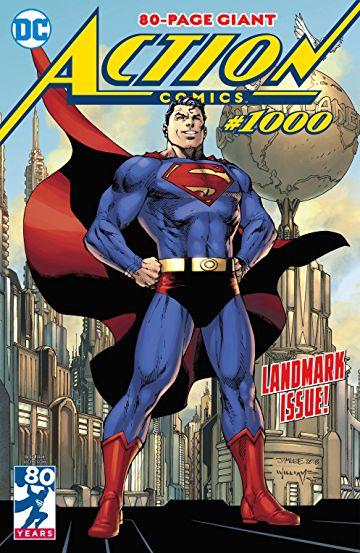In June of 1938, Jerry Siegel and Joe Shuster revealed Superman to the world with a debut to remember in Action Comics #1. Now entering his 80th year of publication, Superman celebrates this momentous achievement with another: the first serial comic book to have released 1,000 issues.
The cover for the issue is underwhelming. Jim Lee’s penicilwork is impressive as always, but the picture itself is rather bland and unimpressive, only showing Superman in front of the Daily Planet. There’s little to differentiate this cover from any other Superman book. Veteran fans will notice the return of the famed red tights, but only the #1,000 and the caption of “Landmark Issue!” will draw the casual observer’s eye.
The issue has no central writer or artist, as it is an anthology of stories to celebrate Superman’s past, present and future adventures. This works to the book’s advantage, as it allows for variation in theme, tone, and message, though the order in which the comic presents them is somewhat chaotic and could have done with some reordering. The story “Never-Ending Battle,” written by Peter J. Tomasi and drawn by Patrick Gleason, shows this best, in which supervillian Vandal Savage throws Superman through time, visiting various chapters in his long history, from stopping a locomotive from running over a child to battling Nazis, and other singularly famous moments in his history. The artstyle changes as Gleason shows us these different periods, such as the more brightly colored pages of the early decades, to Superman’s costume and even linework changing subtly to reflect the era Savage has trapped the Man of Tomorrow in.
Issue 1 cover of Superman released in June of 1938.
The story also highlights how far Superman himself has come as a character in these past 80 years. In the story titled “The Car,” written by Geoff Johns and (yes, THAT Richard Donner, director of the 1978 and 1980 Superman feature-length films) with pencils by Olivier Coipel, a Superman from the golden age of comics does something he likely would have never done in his earliest adventures: offer a chance at redemption to a common criminal. The criminal, named Butch, would have easily fallen in with the crowd Superman described pages ago as “men who might as well have been wearing t-shirts that said, ‘punch me, I’m the bad guy.’”
Instead, Superman gives him a simple offer. “You’ve had your fair share of knocks. And you can keep knocking the world back like you’ve done. Or you can make a decision. Today.” Butch is not the only example within the book either. Throughout the book, criminals are not shown as terrible people or plagues on society, but ordinary people who have trapped themselves in a cycle of being hurt and hurting others. It shows as shift in tone not only in comic book writing, but perhaps American society at large, as we all learned that while becoming a criminal is not always a choice, stepping away from the life is possible with a bit of help from a well-meaning visitor. So powerful is this optimism, that even Lex Luthor, Superman’s archenemy for nearly 80 years of comic history, lays down his arms and simply reminisces with his Kryptonian foe in the story “The Fifth Season,” written by Scott Snyder and drawn by Rafael Albuquerque.
But the final message, not without ulterior motive, is imparted by Gspie in the tale “Actionland!” written by Paul Dini and penciled by José Luis García-López. “I don’t think you want the story to end. Ever,” Gypsy says to Mr. Mxyzptlk, a long-time foe of Superman. And for the past 80 years, we have proven her correct. The public has never turned away from the Last Son of Krypton’s adventures, and from the look of things that will continue for years to come, or, perhaps, as the narrator puts it, until “our time…ends.” But until that time, and perhaps even beyond then, Superman will return whenever we call, just like he teaches the world.




































